
Lesbian feminist icon Magdalen Berns (1983-2019) is most famous for her short, irreverent videos concerned with gender identity politics and women’s rights. Her wikipedia page describes her as ‘a lesbian radical feminist… YouTuber, boxer and software engineer.’
Magdalen’s YouTube channel , with over 32,000 subscribers, features over 60 vlogs designed to offer ‘a counter narrative to media disinformation with blunt humour and honesty; lending a voice to other like-minded women’.

“I am, a lesbian (not the political kind); a physics graduate (University of Edinburgh); a FLOSS accessibility hacker (the legal kind); an XX feminist (not the fun, kind); ex-amateur boxer (the competitive kind); a blogger; an activist; a cultural libertarian; a Londoner; a critic of religion, capitalism, identity politics, conservatism, neoliberalism and socially imposed gender norms.” wrote Magdalen on the ‘about’ page of her channel.
Her political stance on gender politics is summed up in two of her most famous phrases: ‘there’s no such thing as a lesbian with a penis‘ and ‘I’d rather be rude than a fucking liar.’
Magdalen Berns died from glioblastoma on 13th September 2019 in Edinburgh, Scotland. She was 36.
![]()

Conway Hall
Now it is Burns night in London, 25th January 2020. The night is cold and clear and a group of around a hundred people, mostly women, are meeting for a celebration of Magdalen’s life, at Holborn’s Conway Hall.
A few women mill around outside as we step into the stone and marble foyer, hang up our coats and accept a cup of coffee (me) or wine (Lesley & Michèle).
Immediately I see familiar faces among the strangers, chatting, swapping stories about Magdalen, discussing politics.
“It’s like the Golden Globes of radical feminism!” I joke, already wondering if it’s funny before the words are out.
I glance through into the meeting hall and see a large screen with a picture of Magdalen’s face and a computer set up ready to show a slideshow. Engraved into the area above the stage (technically called the proscenium arch evidently) is the immortal line from Shakespeare’s Hamlet, ‘TO THINE OWN SELF BE TRUE’.

Conway Hall is named after Moncure Daniel Conway (1832 – 1907) an anti-slavery advocate and outspoken supporter of free thought. The hall was first opened in 1929 and is owned by the charity Conway Hall Ethical Society. Many talks, lectures, performances and meetings take place there, and its website proudly states that the hall ‘is renowned as a hub for free speech and independent thought’.
It seemed a fitting place to hold a celebration of Magdalen’s life, and with the wine flowing freely, we flowed slowly from the lobby into the hall, taking seats around the tables provided.
There was to be a buffet, music and dancing, but firstly there were short testimonies from some of those who had known or worked with Magdalen.
![]()
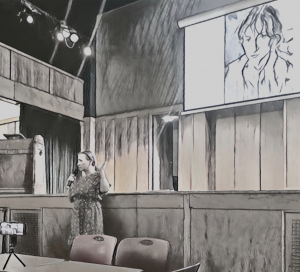 Marion Calder, who Magdalen had entrusted with organising the event, was the first to speak. She told us that while Magdalen wanted her funeral to be held in Edinburgh, she knew many of her friends would not be able to make it up to Scotland, stipulating that a celebration of her life should also be held in London at a later date. Magdalen chose the venue of Conway Hall herself. Not only did she attend events there as a child with her mother, Deborah, but in the last few years she had attended several feminist events within its walls. Magdalen’s mother, we were told, was ill and unable to be at the event but sent her love ‘to each and every single one of you‘.
Marion Calder, who Magdalen had entrusted with organising the event, was the first to speak. She told us that while Magdalen wanted her funeral to be held in Edinburgh, she knew many of her friends would not be able to make it up to Scotland, stipulating that a celebration of her life should also be held in London at a later date. Magdalen chose the venue of Conway Hall herself. Not only did she attend events there as a child with her mother, Deborah, but in the last few years she had attended several feminist events within its walls. Magdalen’s mother, we were told, was ill and unable to be at the event but sent her love ‘to each and every single one of you‘.
Another of Magdalen’s requests concerning the event, continued Marion, was that everyone should be in the same room, different voices all together.
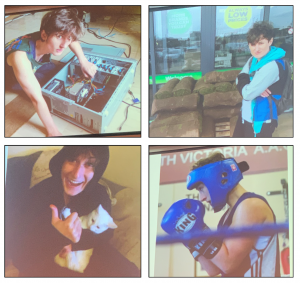
“She wanted everyone to be all together, to chat, to have a glass of wine, to be able to be able to disagree. She was totally against any form of purity politics… what Magdalen wanted was for everyone to have a good time: talk to each other; get to know each other. She, as we all know, was a big fan of a party.”
While Magdalen is no longer with us she leaves the catalogue of her work; her YouTube channel and her Twitter feed. Many young lesbians have approached For Women Scotland since Magdalen’s death, and told of the influence and impact she had had on their lives; many of those had never met her. Likewise, some people attending the memorial had not met her, but had asked to attend because she had touched their lives.
![]()
Nicole Jones, Magdalen’s partner, said that she had first met Magdalen four years ago in the very room we were meeting in. Magdalen was speaking at a feminist event (and here is the link to her talk on the day).
Nicole called her time with Magdalen, ‘some of the most significant years of my life, surrounded by sensational women and at the centre of it, the most sensational woman I could ever hope to meet.”
Describing Magdalen as enthusiastic and compassionate, committed and with a determination to succeed at everything she turned her hand to, whether in boxing, coding or feminism, Nicole spoke of ‘the lives that she touched, the people she inspired and the impact that she’s made’.
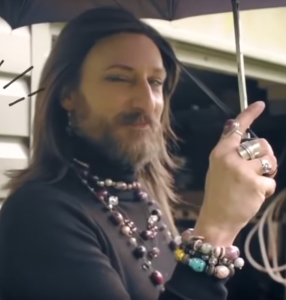
Alex Drummond, ‘widening the bandwidth of how to be a woman’
She then announced that we would watch one of Magdalen’s YouTube videos- the one about Alex Drummond from Stonewall’s Trans Equality Advisory Board, a bearded chappie who famously claimed that he was ‘widening the bandwidth of how to be a woman’.
You can watch it too, and indeed you should: click here to see Magdalen in ‘What Kind Of Fools Do Transgender UK and Stonewall Take Us For?’
![]()
Rowena spoke of having been inseparable at school with Magdalen, going on animal rights protests, anti-war marches and joining the socialist choir. Even as a young girl, “Magdalen was always born to make that difference and she always carried that innate sense of justice that she always had in her heart.”
“Women are like roses,” young Magdalen told Rowena, “We have to grow thorns to protect ourselves because otherwise everyone is going to try and pick us.”
Speaking of Magdalen’s courage and bravery, she concluded “she taught me to fight the fear and do it anyway.”
![]()
Jean Molloy told of how she used to babysit for Magdalen and her siblings. Later she got to know Magdalen as an adult, who was conscious of being a role model for Jean’s own children. She told of a Christmas when the port ran out and Magdalen insisted on going to Aldi for ‘more Christmas’ where she was IDd by a suspicious sales assistant.
“How does she do it?” asked the sales assistant in amazement, after seeing Magdalen’s ID and realising she was the ripe old age of thirty three.
“By drinking loads of port, eating loads of crap and smoking like a trooper,” replied Jean.
![]()
Marion recalled feeling excited at the prospect of meeting Magdalen; being amazed to see how tiny she was, having expected her to be Amazonian because her presence was so huge.
![]()
Lily, who was engaged to Magdalen many years ago, talked about her humour and energy, adding, ‘she basically shaped me as a person‘. She told a tale of how they adopted Potato the cat. Magdalen decided she needed cat to solve a mouse problem, so they went to look at one. The cat immediately attacked Magdalen who promptly offered the owner £60 for it because she ‘really liked her feistiness’.
Marion said that she had inherited Potato the cat – who had messed up her living room – after offering to look after her for a few weeks while Magdalen went into hospital. “Oh, the stories I could tell you about Potato the cat.”
![]()
Gardner met Magdalen through boxing. She spoke of how excited she and her friend were to see their first women’s fight and how impressed they were by how tiny and strong Magdalen was. Magdalen taught her how to ‘swagger’ to show confidence before a fight, telling her ‘make like you’ve got a pair of balls’ and encouraging Gardner not to give up when she felt she’d done badly. That was the year (2011) that Magdalen became boxing champion of all the British Universities. She said Magdalen taught her how to write a good complaint letter (about sexism in boxing) to play air guitar, appreciate Kate Bush & appropriately cheer at a boxing event. Most of all she appreciated Magdalen’s ability to inspire action in others.

Rachel Moran had been communicating with Magdalen on Messenger for a year before she met her and after Magdalen died she went back and read all their correspondence. They met in Dundee when Rachel was talking at an event about the sex trade, which Magdalen was attending, where ‘we got plastered and I was disgracefully drunk’. She said she met Magdalen on only a few occasions, although they messaged and spoke on the phone many times. The night in Dundee, a dinner in London, and two visits to the hospice. Yet, she said, they had a ‘deep emotional bond’ and many beautiful, deep conversations. She commented on the relevance of the Conway Hall message ‘to thine own self be true’.
“Magdalen was true to herself every step of the way. Right up to the bitter end. She was just truthful. She didn’t care what it cost her. She told the truth and advised that other people did the same. And that’s my lasting memory of Magdalen.”

Posie spoke of how ‘Magdalen’s stature and voice betrayed her strength and power’ and how she, Nicole, Venice & Magdalen got ‘absolutely wrecked‘ after the Jam Jar event in Bristol (2018) before deciding the next morning to do a podcast in Posie’s garden.
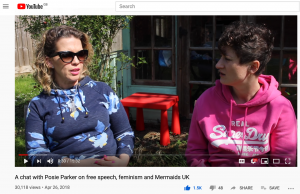 This 15 minute video has had over 30,000 views and you can- and should- watch it here on YouTube.
This 15 minute video has had over 30,000 views and you can- and should- watch it here on YouTube.
A chat with Posie Parker on free speech, feminism and Mermaids UK
Posie joked that Magdalen ‘took sooo long to get ready,’ then paused for a moment before adding, “It’s awful, isn’t it? It’s truly awful that she’s not here but we’re here to celebrate her life and it would have been so nice if we could have done it while she was here to see it…. I’m sure each of us have an individual moment when we’ll remember her the most. I hope we all keep watching her videos because they are still really funny and she does the best South African accent I’ve ever heard.”
![]()
“It’s not about Magdalen the ‘star’, the YouTuber, the feminist, the campaigner, the boxer… I just remember my living room, meeting to discuss women’s issues.. the friendship, the dancing… to this day I miss it.”
Marion spoke of the founding of For Women Scotland, which started with just four women meeting in her living room, herself, Magdalen, Nicole and Trina. The organisation, she said, has now become ‘a force to be reckoned with’, arranging meetings that can no longer be held in living rooms because hundreds of people attend.
“Follow the work Magdalen started a couple of years ago; help support a voice in Scotland, because where we go may happen in England in Wales and across Europe.”
![]()

 There was a buffet served with delicious mushroom balls in breadcrumbs and sweet potato pâté with salad, as well as something with pork. Tea and coffee were available, and the coffee was surprisingly good. Copious amounts of wine continued to flow throughout the evening.
There was a buffet served with delicious mushroom balls in breadcrumbs and sweet potato pâté with salad, as well as something with pork. Tea and coffee were available, and the coffee was surprisingly good. Copious amounts of wine continued to flow throughout the evening.
What a wonderful event, and how perfectly organised.
Donna Summer’s ‘I Feel Love’ was the first track played when the music started and immediately people were up and dancing.
“Not the Sam Smith travesty, thankfully.” observed Lesley.

Donna Summer was followed by Kate Bush, and Grace Slick’s spectacular ‘White Rabbit’. I imagine the playlist was compiled from Magdalen’s favourite music and I take my hat of to her eclectic taste.
“This is amazing. So much love, so much wine and food and great music.”
“Magdalen would have been proud.”
I wandered around the tables talking to people I hadn’t spoken to yet. Several people I wanted to say hi to had left before I got to them, there never seems to be enough time to talk to everyone. I ended up sitting next to Sheila Jeffreys who felt half inclined to dance but wasn’t too impressed with the song that was playing.
Suddenly ‘Jolene’ came on. I’m not a great dancer but I love a singalong and Jolene is a classic. Before I knew it, we were up on our feet and joining the others on the dance floor. And that’s how I unexpectedly came to end my evening dancing with Sheila Jeffreys to the classic feminist anthem (ahem) Jolene.
![]()
Like so many others, I first ‘met’ Magdalen through her amazing videos.
I was especially impressed with her blunt, blindingly obvious, signature phrase ‘There’s no such thing as a lesbian with a penis.’ You can watch her video of the title here. It is classic Magdalen.
She once asked for women to video themselves saying those immortal words. She was going to string them together in a video in a project which I believe was never finished. I was staying with friends in rural America at the time. I took my phone and sat out in the meadow of poppies and butterflies behind the back door, recording myself over and over again until I got the perfect take to send her. ‘There’s no such thing, as a lesbian with a penis. There’s no such thing as a lesbian with a penis. There’s no such thing, as a lesbian with a penis. There’s no such thing as a lesbian with a penis.”
Then I totally got the giggles at how absurd I sounded. How mad the words were and how crazy it was that it was controversial to say them. The moment is as clear in my head now as it was then. I sat in the meadow and I looked at the clouds; the weather was perfect and the sky was blue and I felt very alive.
Thanks for that moment, Magdalen.
As the memorial was held on Burns night, I leave the last words to Robbie Burns himself; changing the him to hers; the she to he.
“Few hearts like hers, with virtue warm’d,
Few heads with knowledge so informed:
If there’s another world, she lives in bliss;
If there is none, she made the best of this.”


 So, hang on, ‘gender non-conforming‘ people? So if a short-haired, plaid shirt and flat-shoes wearing woman is refused a job because of how she dresses, it’s transphobia? If a man with long hair and a tight-fitting flowery shirt is yelled at in the street, that’s transphobia? Well no, obviously not.
So, hang on, ‘gender non-conforming‘ people? So if a short-haired, plaid shirt and flat-shoes wearing woman is refused a job because of how she dresses, it’s transphobia? If a man with long hair and a tight-fitting flowery shirt is yelled at in the street, that’s transphobia? Well no, obviously not. The links to lesbian and gay rights are tenuous too. When lesbians are called transphobic for asserting that they are same sex attracted, it could even be seen as a conflict of interest.
The links to lesbian and gay rights are tenuous too. When lesbians are called transphobic for asserting that they are same sex attracted, it could even be seen as a conflict of interest.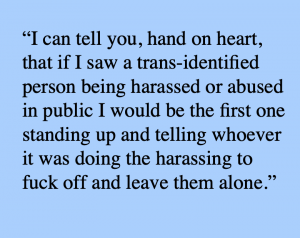 So I suppose there may well be some fear involved in some cases, and understandably so. But a phobia is an irrational fear. Women’s fear that men will hurt them is not irrational because women and girls do get assaulted in washrooms, changing rooms and other female spaces by men who claim to be women.
So I suppose there may well be some fear involved in some cases, and understandably so. But a phobia is an irrational fear. Women’s fear that men will hurt them is not irrational because women and girls do get assaulted in washrooms, changing rooms and other female spaces by men who claim to be women.  Let’s dwell on that for a moment. We have bodies and brains. Our brain is part of our body: it isn’t possible for our brain to be in the ‘wrong’ body. Our brain, like our heart, kidneys and other organs is in the body that it’s in.
Let’s dwell on that for a moment. We have bodies and brains. Our brain is part of our body: it isn’t possible for our brain to be in the ‘wrong’ body. Our brain, like our heart, kidneys and other organs is in the body that it’s in.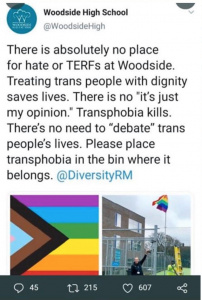
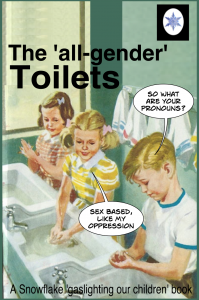
 Progressive, eh?
Progressive, eh?